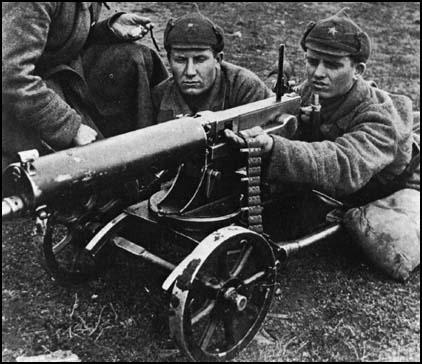Machine-Guns
In 1885 the American inventor, Hiram Maxim, demonstrated the world's first automatic portable machine-gun to the British Army. Maxim used the energy of each bullet's recoil force to eject the spent cartridge and insert the next bullet. The Maxim Machine-Gun would therefore fire until the entire belt of bullets was used up. Trials showed that the machine-gun could fire 500 rounds per minute and therefore had the firepower of about 100 rifles.
The Maxim Machine-gun was adopted by the British Army in 1889. The following year the Austrian, German, Italian, Swiss and Russian armies also purchased Maxim's gun. The gun was first used by Britain`s colonial forces in the Matabele war in 1893-94. In one engagement, fifty soldiers fought off 5,000 Matabele warriors with just four Maxim guns.
The success of the Maxim Machine-gun inspired other inventors. The German Army's Maschinengewehr was based on Maxim's invention. John Moses Browning produced his first machine-gun in 1890 and five years it was adopted by the US Navy.
By the outbreak of the First World War, the British Army had adopted the Vickers Machine-gun Fitted with interrupter gear, the Vickers was also standard armament on all British and French aircraft after 1916. During the war the British also used the Lewis Gun. Easier to produce and far lighter than the Vickers, it was used by soldiers on the Western Front and on armoured cars and aircraft.

In the Second World War the British Army used the extremely reliable Vickers 303. It was a recoil-operated machine gun, water cooled and belt fed. It weighed 40lb without its tripod and fired the standard .303 British cartridge at about 450rpm.
During the war the German Army developed the MG42 machine-gun. Its 1,000rpm could be extremely wasteful during battle. The Red Army used the Maxim-Gun at the beginning of the war but later switched to the drum-fed and gas-operated Degtyarev Model 1940. The United States Army preferred the Browning M2 that fired 100 round belts at 450 rpm.
